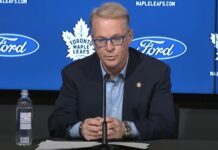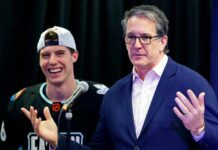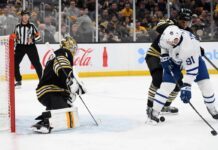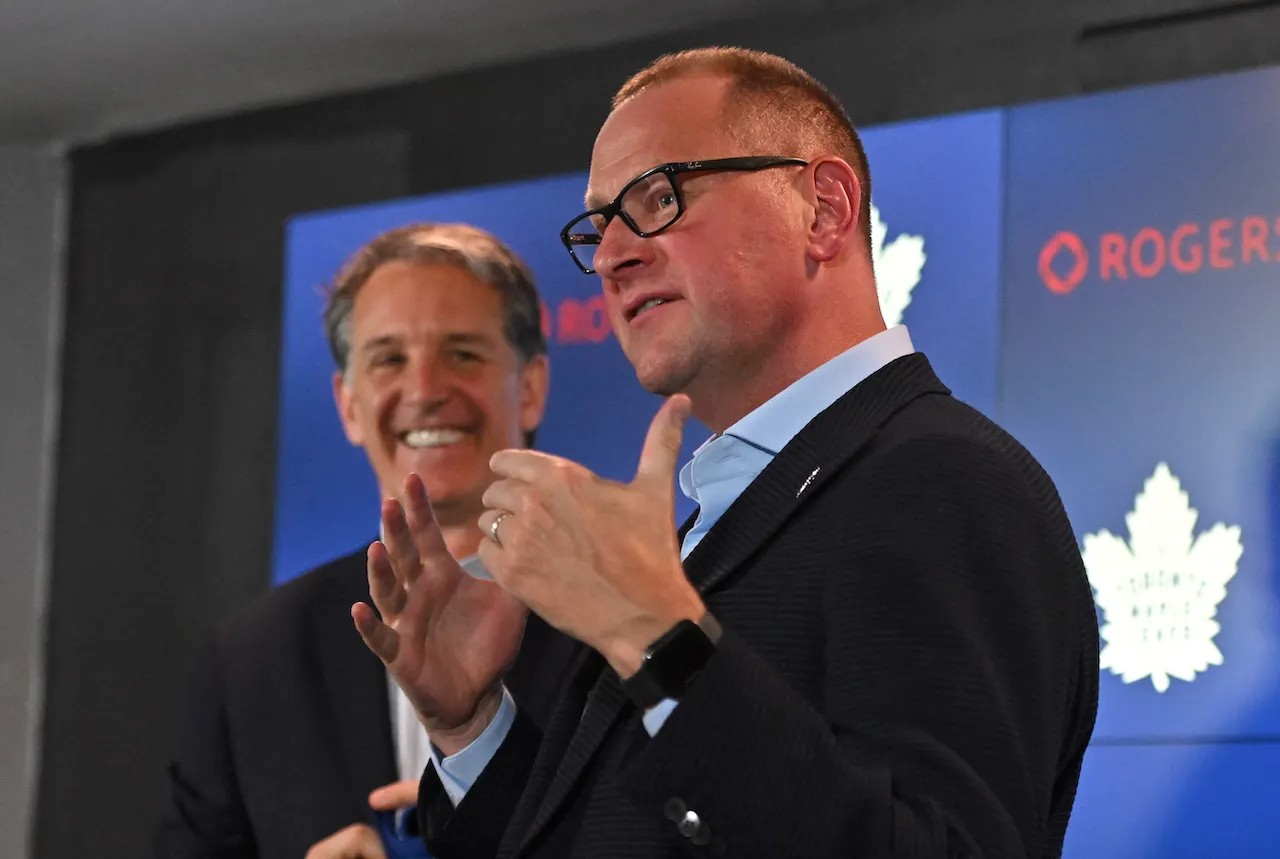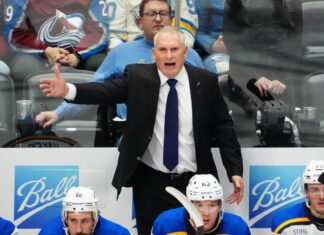With the NHL trade deadline just over a month away and player movement already underway – the Elias Lindholm and Sean Monahan deals kicked off trade season — a lot of attention has turned to what exactly the Maple Leafs will do.
We have already looked at the question of whether the Leafs should buy or sell (the answer is to buy as long as they are a playoff team). Naturally, there is a lot of discussion about who the Leafs may and/or should consider targeting, but before we get to specific trade targets in our next piece, we need to sort through the current roster and identify the areas where the team should focus on improving.
With the Leafs already without a second-round pick in each of the next three drafts or a first-rounder in 2025, they have to be selective in their approach to adding to the roster.
The needs at forward
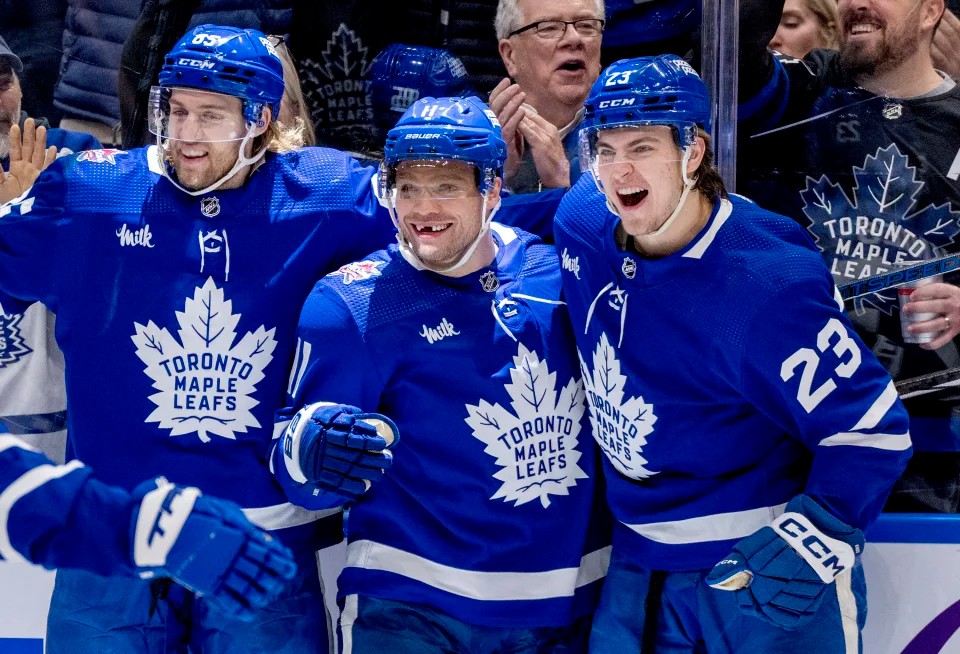
We’ll start at forward, which to me is the most interesting position to sort through.
In the Leafs’ last game – an impressive road win against the Winnipeg Jets – they essentially deployed three rookies in their top-nine forward group: Matthew Knies, Nick Robertson, and Pontus Holmberg. All three played well in the game, and if the team could count on them to consistently contribute, the Leafs would be much more formidable up front.
Technically, the NHL doesn’t consider Robertson or Holmberg rookies as they have each played too many games before this season to qualify, but for all intents and purposes, neither player has come close to playing a full season as a regular NHLer. They are very much going through their first full seasons in the league.
We have talked about this before last season when the Leafs brought Knies into their mix, but the playoffs are not a place for rookies to thrive.
In Vegas, a rookie played all of one game in their Cup run. Colorado’s roster featured one regular rookie – Bowen Byram, a fourth-overall pick – when they won the Cup plus Alex Newhook, who played in 12 games while averaging 10:42 per night. The Lightning dressed one rookie regular in 2021 (Ross Colton) and none in their Cup win the year before, although Carter Verhaeghe played in eight games and Mitchell Stephens appeared in seven. It’s really hard for rookies to contribute every other night in the grueling grind of the NHL playoffs for two straight months.
All three of Knies, Robertson, and Holmberg have flashed promise this season, but as with most rookies, the highs are high and the lows are quite low. Knies is currently mired in a 15-game goalless drought despite primarily playing alongside two elite players. Robertson and Holmberg both played in the AHL to start this season and both have been healthy scratched at times when they have either struggled or been ineffective.
A Sheldon Keefe quote somewhat alluded to this the other week when he was asked about Ryan Reaves’ struggles to get back into the team’s lineup:
“With the way things went early on, it created some opportunity for others — as did his injury — and we have been wanting to give some others a look with Gregor, McMann, Holmberg, and Robertson coming back in. It has made it a little bit harder for someone like Reavo, but we know who he is. We have some younger, inexperienced guys we want to give some time, and then Reavo has had to be more patient as a result. The McMann and Jarnkrok injuries create an opportunity.”
Leafs brass is trying to figure out what they have in these players. How they view each player impacts any potential deadline plans at the forward position.
Knies is a good young player who should be a big part of the Leafs’ future, but his numbers this season are underwhelming for a player in the Leafs’ top six. He’s currently playing to roughly a 15-goal, 31-point 82-game pace (his NHLe entering the season was 29, for what it’s worth).
Knies struggles on the breakout, and while there are benefits to playing alongside the Leafs’ top players from a skilled linemates perspective, it also means he lines up against the other team’s best, a matchup that has been overwhelming for him at times against top teams.
One of the most concerning aspects is that Knies is barely shooting with just 57 shots on net through 45 games so far. Skilled power forwards should be getting to the net and racking up high shot totals regularly. Even Michael Bunting, who isn’t really a power forward but went to the net regularly, launched over two shots on net per game.
If we want to be glass half-full about a young player, we can always hope he will improve as the season goes along. It’s not unreasonable to think that as Knies continues to adjust to the league, he will figure it out and start impacting games regularly. He clearly has the physical tools (size, strength, speed, skill) to play at this level. A lot of the next steps are about really figuring out the league and refining the details of his game.
Truthfully, any sort of improvement in Knies’ game would be a significant development for the Leafs’ playoff chances. Even with the typical rookie ups and downs, the top line with Knies on the left wing sits at 14-8 in five-on-five goals while decidedly controlling possession and expected goals.
Similar sentiments can be applied to Nick Robertson. The difference is that he’s playing lower in the lineup and has been performing well in his minutes primarily alongside Domi – they are up 13-9 in five-on-five goals and sit at just under 55 percent of the shot attempts, although those minutes have been sheltered.
Robertson also seemed to hit a wall earlier in the season, which Sheldon Keefe acknowledged:
“We played him about 24 or 25 games in a row off his recall. He had done well for us there, but I thought he really sort of leveled off or plateaued for the last 10 games or so. To me, it encouraged us to give him some breaks. While he has come in and out of the lineup — especially this month when it’s been a very challenging schedule for us in competition, the volume of games, and travel — he has given us a boost and a jolt. He is energized.”
When he comes in hungry and motivated, Robertson is a game-breaker. He owns an elite shot and doesn’t need much of an opportunity to score. But, as Keefe noted, he did have a stretch of play where he was a regular in the lineup and was struggling to make much of an impact while also experiencing difficulties on the breakout.
Robertson is playing near a 20-goal, 40-point pace over 82 games in a third-line role and has been given a linemate – Max Domi – whom he can make plays with. If he sustains his play, he’s going to be in the lineup. Even if he does need the occasional reset – not unusual for many young players – the payoff is worth it.
Knies and Robertson would represent two risk/reward type players in the team’s top nine.
A few years ago, the Florida Panthers won the President’s Trophy and went into the playoffs with two players in similar-ish situations in their top nine, rookie Anton Lundell and a first-time full-season player in Eetu Luostarinen. The Panthers made a disappointing second-round exit as Lundell recorded one point in nine playoff games and Luostarinen produced two in 10.
The following spring, with the experience of the prior year, both were excellent as the Panthers went to the Cup final (Lundell produced 10 points in 21 games, and Luostarinen recorded five in 16 before missing the finals, an absence the team certainly felt).
And then there is Pontus Holmberg, who is a little older at 24 (he’s turning 25 in March) but has yet to play a full season in the league. Last season, he played 37 games, but he really hit a wall toward the end and ended up back with the Marlies. At one point last season, he looked like a roster staple. Sheldon Keefe was pumping up how good his game tape looked at one point – mentioning that he didn’t look like a rookie — but the grind of the season caught up to him.
Holmberg went down to the Marlies and produced a good playoff series with six goals and eight points in seven games. In 2020-21 in the SHL, his team won the championship and he was named playoff MVP with 14 points in 14 games. Those are different leagues, but he has shown some big-game chops.
Recently, with the Leafs, Holmberg has responded well to a move to the wing. He has played on the top line, the third scoring line, and a checking line while generally showing well. The third line was really good against a good Jets team on the road where Winnipeg owned the last change and wanted to take advantage of them. A few games earlier, Holmberg helped the Leafs close out a lead on a line with David Kampf as the pair ground the Kraken down in their own zone (the ideal way to see out a victory late in regulation).
Holmberg has the lowest ceiling of the three players, but he’s older and more mature in his details, making him the safest bet as a player the coach can trust. I don’t think it would be the best approach to trying to win it all for this season, but it could be the type of move that pays dividends as early as next season. The Leafs would not be punting on this playoffs by any means by running with the younger players, and they’re building a secondary layer of support that’s all under contract already for next season (as are all of their top players).
Short of the Leafs actively moving a veteran forward (which is highly unlikely to happen), there are eight roster spots accounted for one way or another: Auston Matthews, Mitch Marner, William Nylander, John Tavares, Tyler Bertuzzi, Domi, Jarnkrok, and Kampf. The Bertuzzi – Tavares – Nylander line has been consistently very good in terms of controlling play and outscoring opponents. As mentioned, Knies – Matthews – Marner has won their minutes as has Robertson – Domi.
Noah Gregor is also in the mix, but by no means has he done anything to lock himself into a permanent lineup spot. The same can be said of Bobby McMann, to some degree.
Add it all up, and if we insert the three young forwards, the forward lineup is all but accounted for save for one spot.
Given the Leafs’ struggles on the penalty kill and protecting leads, adding a good, experienced checker would make sense. Alternatively, a secondary scoring option that allows them to move up Jarnkrok to check alongside the top players – or down to check alongside Kampf – while giving Domi another skilled player to work with could also make sense.
There are good, useful players throughout the Leafs forward group. One more trustworthy forward who can contribute at each end of the ice would round out the whole group quite well.
The needs on defense
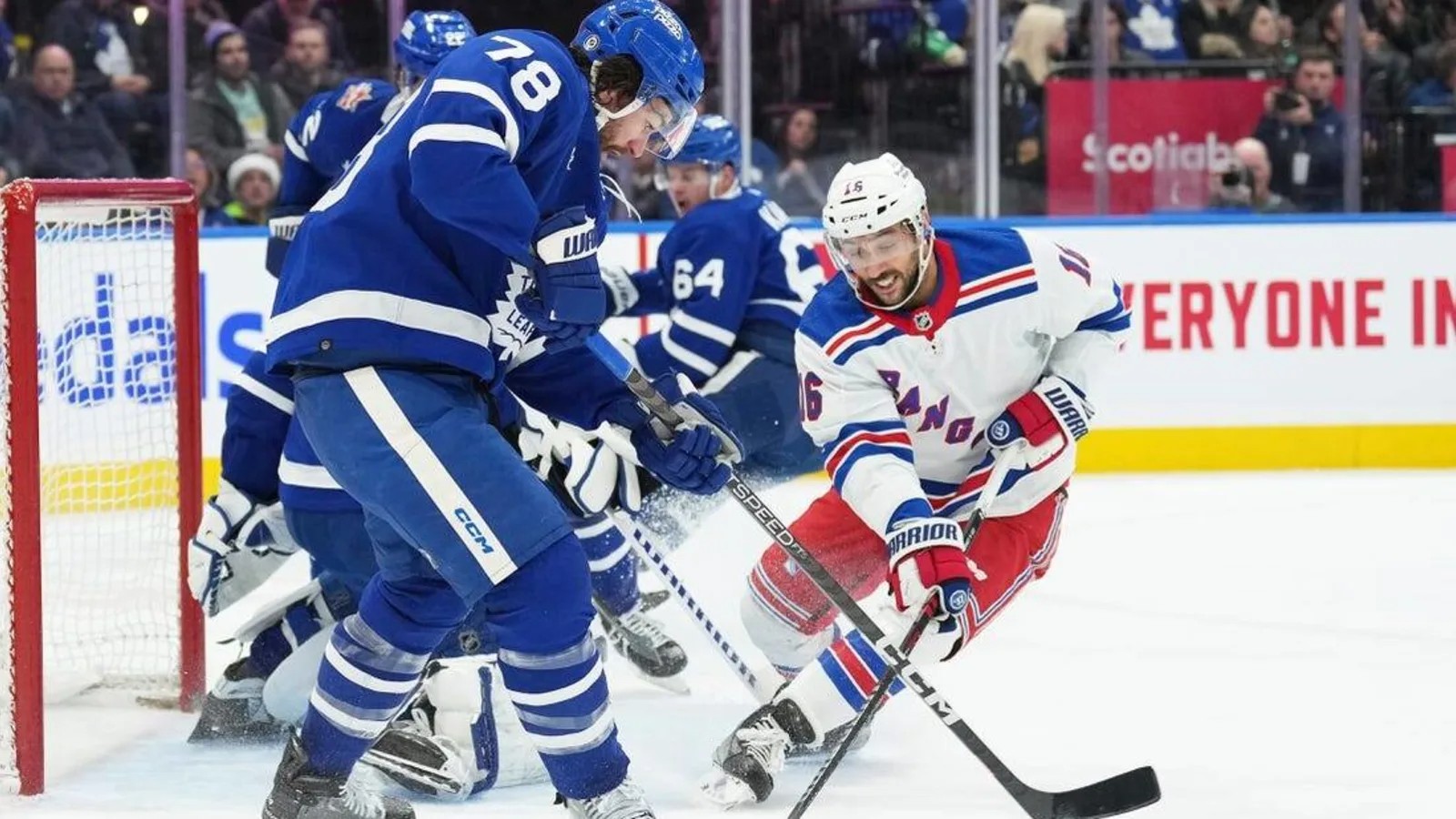
The blue line is a different story.
With certainty, it’s fair to suggest Morgan Rielly and Jake McCabe are locked in. Simon Benoit is all but locked in at this point, too, unless he hits some sort of wall in his play having never actually been on a good team with real expectations in the NHL before.
Mark Giordano and Conor Timmins are good depth options, but it would be difficult to trust either on a nightly basis.
After those players, the debates begin.
TJ Brodie has clearly taken a step back so far this season. He’s on a $5 million AAV expiring contract, but in actual salary, he’s making $7.5 million this season, rendering him all the more difficult to move. The only reason the team would even consider a move here is to open up the cap space to bring in a big name.
Failing that, it would be hard to work out the gymnastics of moving Brodie and improving the defense; shifting Brodie down the lineup would still be a better option over a Mark Giordano at this point. Brodie is also one of the team’s only reasonable penalty killers. The easiest move would likely involve adding a defenseman who pushes him down the lineup.
And then there is Timothy Liljegren. Unlike Brodie – who is aging out – Liljegren is just 24 and has played 171 games played in the league. His game hasn’t quite taken off as everyone hoped it would by now, but he is right around the age and games-played mark where defensemen start to break out.
Morgan Rielly, for example, broke out offensively with a 52-point season in his fifth season in the league. His previous high before then was 36 points, which was also the only time he passed 29 points in his first four seasons.
This is not to suggest Liljegren is untouchable, but it would be hard to look at an aging defense core lacking in right-handed shots and watch the Leafs trade him away for the sake of it. If it’s part of a hockey trade that nets the team some real upside, it makes sense, but they aren’t exactly dealing from a position of strength here.
The ideal solution might involve acquiring a partner for Rielly that allows them to pair Brodie with Liljegren. Brodie, who is struggling with the puck on his off-side – especially offensively – can move to the left. Liljegren would receive a veteran partner who would hang back and cover for him in a way that more adventurous offensive partners like McCabe or Giordano would not.
Earlier in the season, it was rumoured that Brad Treliving was interested in acquiring both Nikita Zadorov and Chris Tanev. That was before Simon Benoit really cemented a roster spot, though. Benoit’s emergence somewhat allows them to focus on simply adding one quality defenseman.
In terms of a seamless addition that would drop their defensemen more into their proper place in the pecking order, a partner for Rielly is the most logical move to make.
However, this is also a defense with only Rielly, McCabe, and Timmins signed for next season. Benoit and Liljegren are pending RFAs. The position needs an injection of talent. Any sort of swing on a needle-moving defenseman would make sense at this rate provided it’s a player who is already signed or is acquired with an extension in place. There are useful defensemen in the Leafs’ mix, but there’s only one real difference-maker.
The bigger opportunity to retool the defense will come in the summer. For now, any sort of quality addition on defense, preferably a right-handed option, should be priority one, two, and three.
Beyond that, a proven two-way forward would give the Leafs some real versatility and additional dependability up front.
There would still be holes in the roster – nobody is suggesting this would make the Leafs the team to beat in the 2024 playoffs – but there are no perfect rosters in the league. In the cap world, every club has a hole or two.
Treliving shouldn’t be pursuing a dramatic trade deadline such as last season’s or the one in 2021, both of which featured a flurry of trades. If he adds one quality forward and one quality defenseman while the team returns to full health in net, this should be a tough Leafs team to beat in a seven-game series.



